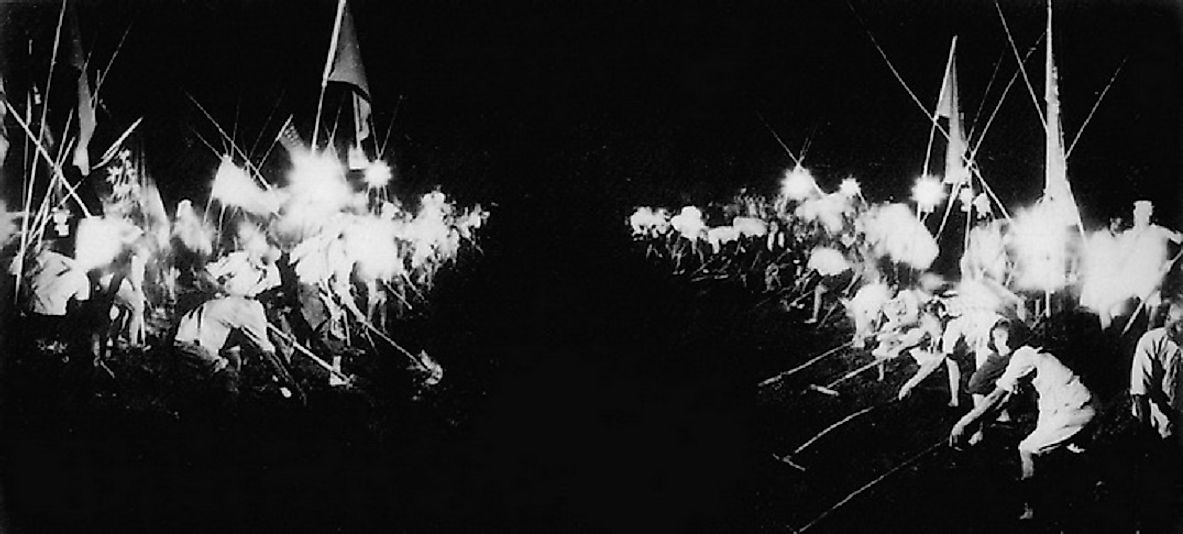What Was The Great Leap Forward In China?

The Great Leap Forward in China was meant to turn China into a modern socialist state in the mid-20th Century, although many argue the campaign almost ruined China. Beginning in 1958, and going on to 1961, Mao Zedong led the Communist Party of China in advocating and implementing a social and economic campaign known as the Great Leap Forward, with the intention of bringing rapid transformation of China from an agriculture-dependent economy into a socialist society. Mao hoped to achieve this goal by rapidly industrializing the country and by collectivization. The policy, however, backfired, resulting in what was known as the Great Chinese Famine or the Great Leap Forward Famine, lasting from 1959 until 1961, and leading to the deaths of tens of millions of people in China.
Origins
Traditionally, each farmer in China farmed his own piece of land. In the period between 1949 and 1958, a policy of collectivization, where farmers would work in collectives and share tools and draft animals, was gradually introduced and implemented. By 1958, these agricultural collectives had become the norm, and private ownership of land was abolished, with all households being forced into the state-operated communes. In 1957, at the 40th anniversary of the October Revolution, this was held in Moscow, Khrushchev the Secretary of the Central Committee, proposed the goal of catching up with and surpassing the United States in industrial output within 15 years. The move led to the conception of Mao Zedong’s parallel objective for China, that it should catch up to and, if possible, even surpass the United States within 15 years.
Key Figures
Mao Zedong, who is popularly known as Chairman Mao, was the founding father of the communist People’s Republic of China. His communist theories and policies are commonly known as Maoism. Hoping to accelerate China’s economic growth, and transform it into an industrial nation, he launched the Great Leap Forward, an ambitious but poorly planned and executed a plan which led to the loss of millions of lives. The Communist Party was instrumental in implementing the policy.
Notable Events and Programs
Abolishing private property, Mao introduced the communes. In these communes, people were paid by work points rather than wages. Besides, Mao introduced the backyard furnaces, whereby each commune or neighborhood would have such a furnace, and citizens would toil at manufacturing steel. Mao believed that steel production was one of the key factors needed for true economic growth and development. There were numerous large-scale irrigation works, which because of poor planning and the absence of input from qualified engineers, resulted in the deaths of hundreds of thousands. There were several experiments in the agriculture sector, with policies such as close cropping, deep plowing, and others which were derived from the ideas of Trofim Lysenko, a Soviet agronomist who is now discredited. Though these innovations were meant to increase productivity, they led to the opposite, and there was a decrease in the grain produced. Many restrictions were imposed on rural people, with the communes being forced upon them and private farming prohibited. Those who disobeyed the law, and refused to join the communes, or engaged in private farming were persecuted, being named counter-revolutionaries.
Successes and Failures
The Great Leap Forward period was scarred by the deaths of millions. There were several reasons for these deaths. Some died from the coercion, terror, and violence meted out by party members and militia. Others died from starvation during the Great Chinese Famine, which was caused by unfavorable weather as well as the social pressure, mismanagement of resources, and radical changes in agricultural policy introduced by the government. Though the intention was for the Chinese economy to surpass that of the United States, the opposite happened and the economy shrank. They were years of economic regression. During the first year of the Great Leap, however, there was initial growth, with a 45% increase in production of iron in 1958, only for it to fall in 1961, and not recovering until 1964.
Legacy
The years following the Great Leap were not favorable to Mao Zedong, and he was criticized heavily and blamed for the negative effects of his policies. Marginalized within the party, Mao took a step back but returned to prominence in 1966 when he initiated what he called the Cultural Revolution. Sources which favor Mao are more often seen contending that the Great Leap Forward did not cause the Great Chinese Famine and that, contrary to popular opinion, the campaign succeeded in promoting rapid industrialization in China. The Great Leap Forward is credited for being the most ambitious movement in modern China, while at the same time being the most disastrous. The main reasons for its failure were poor planning, not involving skilled professionals, politicization, and poor implementation.











